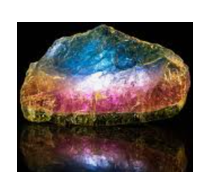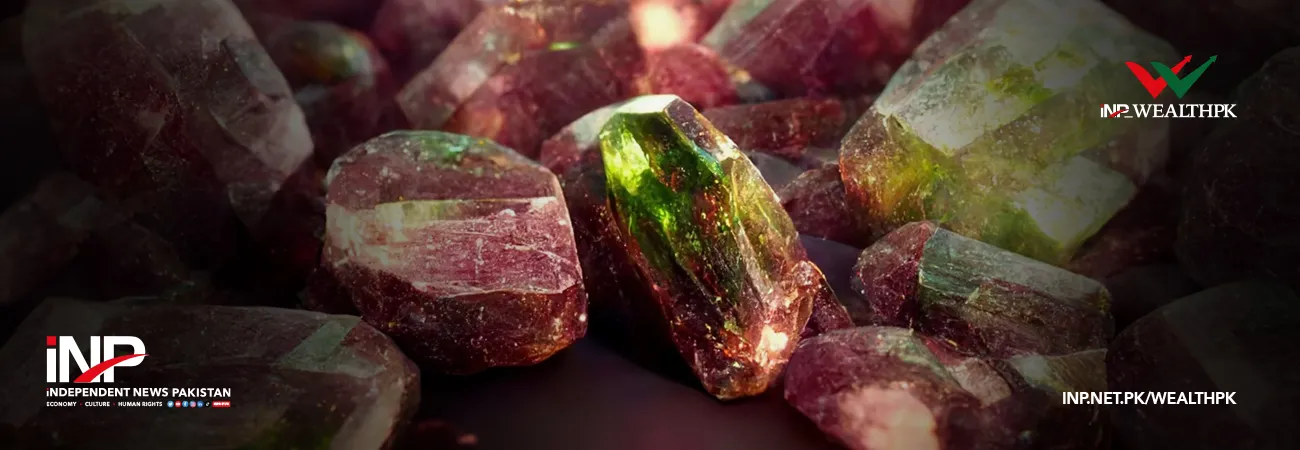INP-WealthPk
Faiza Tehseen
The extraction of rare earth elements (REEs) and heavy rare earth elements (HREEs) from tourmaline can fetch opulence for estate wallets.

“A deep survey to explore more deposits of tourmaline in Pakistan is direly needed. Proper exploration and processing of tourmaline is necessary for meeting industrial needs and boosting exports,” said Abdul Bashir, chief geologist with a Balochistan-based mineral exploration firm. Talking to WealthPK, he said, “To extract the REEs/HREEs from tourmaline, further research and analysis is needed to help quantify its deposits and to determine the exact element present in the given sample.” He explained that tourmaline was a borosilicate mineral compounded with lithium, magnesium, sodium, potassium, aluminum, iron and various other elements containing REEs and HREEs. “The said elements may cause variations in their color and luminescence. Currently, 13 different tourmaline species are acknowledged. About 43 minerals are approved in the tourmaline group, occasionally occurring in sedimentary and mostly in igneous and metamorphic rocks.” He said that tourmaline was called the electric stone, as when it was heated or physically stressed, it produced and held the electric charge.
“Schists, granites, and gneisses are the known host rocks of tourmaline. Gem-quality tourmaline mostly occurs in pegmatites containing low REE concentrations. Vanadium and Chromium-rich tourmalines often originate from ultramafic and lithium from granite and granite pegmatites. Its known species are elbaite, liddicoatite, dravite, uvite, and schorl.” Bashir said, “With hardness between 7.0 to 7.5 in Mohs scale, tourmaline occurs in a variety of colors due to its complex mineralization. The high concentration of iron/manganese in allochromatic tourmaline makes it magnetic. Schorl or black tourmaline absorbs pyroelectricity, far infrared emissions, ions, and negative air ions. It is a detoxifier, a biological activity influencer, and also an important petrological and geochemical indicator.” He said, “In Balochistan, it occurs in many places – Chagai, Ras Koh Mountain range, Khuzdar and Zhob. The government must initiate proper research and investigative plans to explore tourmaline deposits across Pakistan to create more job and business opportunities.”
Meanwhile, Imran Babar, gemmologist and miner, said, “Tourmaline belongs to the boronsilicate family. Different inclusions cause different shades in it. Mostly, it is found in granitic mountains and also in matrix gypsum/mica/garnet/quartz. Within the granitoid and metamorphic rocks, tourmaline naturally occurs in the crystallized form in different colors and sizes.” Speaking to WealthPK, he said due to different inclusions, tourmaline was naturally formed in a variety of colors – black, pink, light pink, red, yellow, green, black, blue, violet and champagne. “In Pakistan, almost all colors and varieties are available. Big pockets in Khyber Pakhtunkhwa province are mostly loaded with sizeable black variety. Chitral, Koh-e-Suleman range, Shigar Valley, Stak Nala, Gilgit, Skardu, Haramosh and Roundu are considered the main hubs of tourmaline.” Imran said that the complex mineralization of tourmaline made it a natural wonder with considerable traces of REEs and HREEs. “Policymakers in Pakistan need to consider them on a priority basis for socioeconomic benefit of the country.”
Credit: INP-WealthPk













